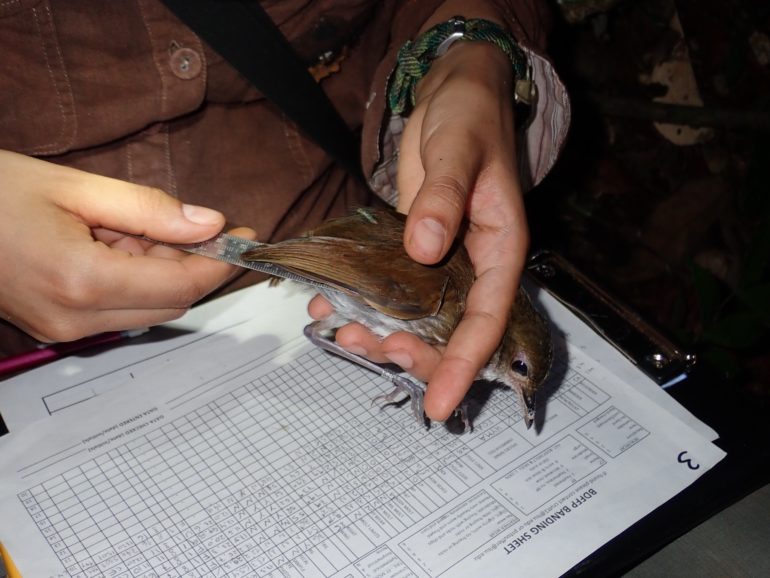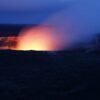The most pristine parts of the Amazon rainforest devoid of direct human contact are being impacted by human-induced climate change, according to new research by LSU scientists. New analyses of data collected over the past four decades show that not only has the number of sensitive resident birds throughout the Amazon rainforest declined, but the body size and wing length have changed for most studied species. These physical changes in the birds track increasingly hot and dry conditions in the dry season, from June to November.
“Even in the middle of this pristine Amazon rainforest, we are seeing the global effects of climate change caused by people, including us,” said Vitek Jirinec, LSU alumnus (Ph.D. ’21), associate ecologist at the Integral Ecology Research Center and lead author to this study published in the journal Science Advances.
Birds in the Amazon rainforest have become smaller and their wings have become longer over several generations, indicating a response to the shifting environmental conditions that may include new physiological or nutritional challenges.
This is the first study to discover these changes in non-migratory birds’ body size and shape, which eliminates other factors that may have influenced these physiological changes. Jirinec and colleagues studied data collected on more than 15,000 individual birds that were captured, measured, weighed, marked with a leg band and released, over 40 years of field work in the world’s largest rainforest. The data reveal that nearly all of the birds’ bodies have reduced in mass, or become lighter, since the 1980s. Most of the bird species lost on average about 2 percent of their body weight every decade. For an average bird species that weighed about 30 grams in the 1980s, the population now averages about 27.6 grams. How significant is this?
“These birds don’t vary that much in size. They are fairly fine-tuned, so when everyone in the population is a couple of grams smaller, it’s significant,” said co-author Philip Stouffer, who is the Lee F. Mason Professor in the LSU School of Renewable Natural Resources.
The data set covers a large range of the rainforest so the changes in the birds’ bodies and wings across communities are not tied to one specific site, which means that the phenomenon is pervasive.
“This is undoubtedly happening all over and probably not just with birds,” Stouffer said. “If you look out your window, and consider what you’re seeing out there, the conditions are not what they were 40 years ago and it’s very likely plants and animals are responding to those changes as well. We have this idea that the things we see are fixed in time, but if these birds aren’t fixed in time, that may not be true.”
The scientists investigated 77 species of rainforest birds that live from the cool, dark forest floor to the warmer, sunlit midstory. They discovered that the birds that reside in the highest section of the midstory and are the most exposed to heat and drier conditions, had the most dramatic change in body weight and wing size. These birds also tend to fly more than the birds that live on the forest floor. The idea is that these birds have adapted to a hotter, drier climate by reducing their wing loading therefore becoming more energy efficient in flight. Think of a fighter jet with a heavy body and short wings that requires a lot of energy to fly fast compared to a glider plane with a slim body and long wings that can soar with less energy. If a bird has a higher wing loading, it needs to flap its wings faster to stay aloft, which requires more energy and produces more metabolic heat. Reducing body weight and increasing wing length leads to more efficient resource use while also keeping cooler in a warming climate.
LSU alumnus Ryan Burner (Ph.D. ’19) conducted much of the analysis that revealed the variation among the groups of birds over the years. Burner, who is now a research wildlife biologist at the U.S. Geological Survey Upper Midwest Environmental Sciences Center, is the second author of this study.
The question of the future capacity of Amazonian birds to deal with increasingly hotter and drier surroundings, especially in the dry season, remains unanswered. The same question can be asked for a lot of places and species that live at the edges of even more environmental extremes.
“There may be other researchers in other places who have relevant data from the 1970s and 1980s that could be compared to modern data, because the bird banding protocol we used is pretty standard. So if you measure mass and wing, maybe there will be more datasets that will emerge and we’ll be able to get more of an idea of the variation across space and how it might be changing in different systems,” Stouffer said.



